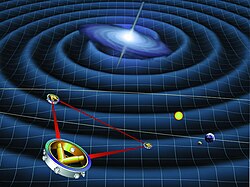Laser Interferometer Space Antenna

The Laser Interferometer Space Antenna (LISA) experiment is a joint venture of NASA and the European Space Agency (ESA) to detect and observe in detail gravitational waves from astronomical sources. In 2008 ESA reported LISA was in the mission formulation stage with the earliest possible launch in 2018.[1][2] ESA reports that LISA is expected to stay in orbit for two years starting some 16 months after launch.[3]
LISA is intended to measure gravitational waves by using laser interferometry over astronomical distances. It will use three spacecraft arranged in an equilateral triangle to form a giant Michelson interferometer with arms about 5 million kilometers long. When a gravitational wave disturbs the space-time field between two of the spacecraft, small differences in the relative lengths of the arms should be measurable.
Overview
A Michelson interferometer consists of an L-shape with two long arms, each terminated with a mirror, and a corner station containing a light source, beam splitter and combiner. Since forming LISA's arms requires three widely separated spacecraft, three identical spacecraft are used, each at the corner of a pair of arms. Each satellite will have two optical assemblies, arranged 60 degrees from each other, and each pointing at one of the other spacecraft. This forms two independent interferometers between the three craft.[4] This makes it easier to design, test, and deploy only one type of spacecraft, and the redundancy helps to validate the data. Also, three spacecraft in a triangle formation will provide increased sensitivity to incoming gravitational waves.
To eliminate non-gravitational forces such as light pressure and solar wind, each spacecraft is constructed as a zero-drag satellite. The end of each interferometer arm is defined by the mirrored surface of an internal "proof mass" (made of 75% gold, 25% platinum), and the surrounding spacecraft uses capacitors to measure the position of the test mass relative to the spacecraft, and very precise thrusters to keep itself centered on the proof mass.
The entire arrangement, which is ten times larger than the orbit of the Moon, will be placed in solar orbit at the same distance from the Sun as the Earth is, but trailing the Earth by 20 degrees, and with its orbital plane tilted relative to the ecliptic by 60 degrees. The mean linear distance between the constellation and the Earth will be 50 million kilometers.
The main goal of LISA is to study gravitational waves in detail. In this effort the LISA mission will test Einstein's theory of gravity. Many physicists believe that gravitational waves exist as there is indirect evidence from the observation of decreases of the orbital period of pulsars, such as the famous PSR 1913+16. However, gravitational waves have never been directly observed because of their extremely small effects on matter. Observing them requires two things: a very large event generating the gravitational wave — such as colliding black holes — and extremely high detection sensitivity. The LISA instrument should be able to measure displacements with a resolution of 20 picometers over a distance of 5 million kilometers, yielding a strain sensitivity of better than 1 part in 1020.
Other Gravitational Wave Observatories
There are other gravitational wave antennas, such as LIGO, VIRGO and GEO 600, which are already in operation on Earth, but their sensitivity at low frequencies is limited by practical arm lengths and interference from moving masses on the planet (e.g., logging operations and highway traffic around the telescope).
A single satellite ("LISA Pathfinder") is due to be launched in 2009 to validate the design and configuration of the definitive mission starting after 2018.
The mission is sponsored jointly between NASA (which will provide the launcher, the three spacecraft, and about half of the science payload) and the European Space Agency (providing the propulsion modules, and half of the science payloads through national contributions) under the Beyond Einstein program.
See also
- Beyond Einstein program
- Big Bang Observer
- Laser Interferometer Gravitational-Wave Observatory (LIGO)
- Great Observatories program
- Constellation-X
References
- ^ "ESA Science & Technology: LISA". Retrieved 2008-02-05.
- ^ "ESA Science & Technology: Cosmic Vision". 2008-01-14. Retrieved 2008-02-05.
- ^ "ESA Science & Technology: Fact Sheet". 2007-09-05. Retrieved 2008-02-05.
- ^ "ESA Science & Technology: Spacecraft". 2007-09-06. Retrieved 2007-04-17.
External links
"NASA's LISA page". 2007-05-14. Retrieved 2008-02-05.
"LISA page of the Max Planck Institute in Hannover, Germany". 2008-03-01. Retrieved 2008-03-01.
